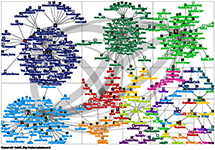Bryan Lee
July 18, 2014

Network diagram showing Twitter discussion during the 2014 Preparatory Committee meeting of the Treaty on the Non-Proliferation of Nuclear Weapons
After eighteen months of work, the Nuclear Threat Initiative (NTI)’s Verification Pilot Project released its final report on how society, not just governments, can contribute to the verification of arms agreements through the use of social and new media. The report brought together eleven experts* from academia, government, and the Department of Energy’s national laboratories to examine the potential of emerging internet technologies to support arms control treaty verification. The report offers useful recommendations to both policy makers and technical specialists. The findings serve to reiterate two key points identified in CNS’s research on the topic. First, governments and international organizations like the International Atomic Energy Agency need to immediately start building a management and analytical infrastructure that understands these technologies and create and implement policies to use them. Second, these technologies greatly enhance the ability of outside experts to contribute to problem solving, and governments and organizations should work on methods to identify and tap into this expertise.
One of the great strengths of the report is its effort to place new media tools in the broader context of how governments adopt and adapt to new technologies. Historical case studies on the telegraph, radio, and commercial satellite imagery show governments often struggle for decades before learning how best to incorporate new technologies into existing practices. For this reason, it is only natural for governments and other large organizations to move slowly, especially with respect to verifying weapons of mass destruction. The risks are high and caution is warranted—especially in the commercialized and hype-soaked world of the internet.
Still, it would be a mistake to dismiss these technological developments. The NTI report offers several examples of research that clearly point the way to a future where potential treaty violations will be observed and reported automatically. CNS would argue many of these tools have an even wider potential for use. Inspection training, nuclear industry knowledge management, public diplomacy, and education and outreach are only a few of the uses that are ready today and do not present the legal or ethical conundrums of traditional data monitoring by the defense or intelligence communities.
To realize the true potential of these tools, experts and governments both will need to become comfortable with a much more open information environment than existed in the past. Motivated amateurs will function as credible data sources and may offer insights or experience that experts will find useful. Governments will find themselves incapable of managing and analyzing the large amounts of available data and will increasingly turn to outside experts to help make sense of it all. To the extent these groups begin working now to understand how to structure this cooperation, the more successful all will be.
CNS has long been a leader in open source methods, going back to our first research projects on the international supplier market for Iraq’s centrifuges. At the time, no one believed such critical information could be found in trade journals and newspapers. Today, trade journals and newspapers have moved online, shipments are tracked via GPS, and customers confirm delivery over their smart phones. CNS research continues to highlight the worth of this public information, and our nonproliferation education efforts embrace new media technologies such as geospatial tools, 3D modeling, simulations, and text mining. This new NTI report reinforces our own analytical and training efforts, and offers a valuable contribution to the argument in favor of a twenty-first century version of societal verification.
—
*Bryan Lee was a contributing member of the report.
